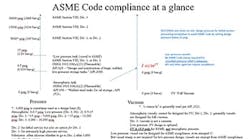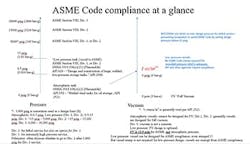A silo collapsed at an acid regeneration plant near Chicago. This “silo” actually was a low-pressure vessel, according to American Society of Mechanical Engineers (ASME) code. It collapsed because the instrument that protected it failed. The instrument has been installed because the designers thought that a vessel operating near but not above 15 psig didn’t need to be built to withstand full vacuum. ASME Section VIII requires a stamp above 15-psig pressure. This same company also suffered a similar type of failure at a Spanish site; it involved a blocked-in drain line on a large fiberglass atmospheric tank and a hydrostatic test in +90°F temperatures.
[pullquote]
As an aside, process safety pioneer Trevor Kletz in “Still Going Wrong!: Case Histories of Process Plant Disasters and How They Could Have Been Avoided,” p. 177, points out that drain holes, which were missing in the Spanish vessel, are intrinsically safe “devices” and should be included in an inspection plan — and probably in the design review as well.
My point is that grey areas and gaps exist in safety pressure codes, not just in the United States but elsewhere, including in Europe. This problem is especially acute for low-pressure vessels that don’t require ASME stamps. So, here, I will focus on these vessels.
First, let’s define a low-pressure vessel according to the standards that apply in the United States. Such a vessel has a design pressure of 15 psig or lower. It may or may not be designed for full vacuum (FV). Most manufacturers will assume you want a new vessel designed for FV, i.e., 15-psig external pressure. You may think that you can save a few dollars by not requiring an FV rating but you probably won’t. By the way, the ASME code considers 15 psig, not atmospheric pressure, as FV.
Here is a simple look-up chart for compliance with ASME Section VIII, Unfired Vessel regulations. Source: Dirk Willard
Here’s another point: ASME Section VIII, Division 1 and Division 2 don’t cover external pressure; they only pertain to internal pressure measured at the top of the vessel. It’s the responsibility of the fabricator to design the vessel bottom for static pressure, such as that of a height of liquid. As far as I understand, ASME doesn’t require a stamp if the bottom pressure exceeds 15 psig.
I must stress that there’s no reason, other than cost, not to design a vessel to ASME Section VIII standards. It’s even possible to get a U stamp for a low-pressure vessel. The cost is about $800 (as of 2018) for a stamp, excluding a pressure test, an inspection report, and calculations by a professional engineer; with those, the tab increases to ≈$7,000. A new vessel also will require a mill chemical test (which is done by the metal producer, not the fabricator). If this is missing, you must perform positive material identification (PMI) by x-ray fluorescence (XRF) or optical emission spectroscopy; XRF is easiest to use. A PMI usually looks at the heads, shell and, especially, weld seams. An inspection report also generally requires an ultrasonic thickness test spaced along the length of the shell, at nozzles and knuckles, and on the heads. This underscores the advantage of insisting upon a low-pressure vessel designed to meet ASME code — you’re assured of quality. Far too often a non-code low-pressure vessel is just slapped together with different materials and welds, inappropriate nozzle connections and even nozzles installed on knuckle seamlines. You don’t want that kind of surprise!
[callToAction]
Even if the ASME code doesn’t seem to apply, other guidelines may. For instance, the U.S. Occupational Safety and Health Administration considers the standards of the American Petroleum Institute (API) gospel: API 620, “Design and Construction of Large, Welded, Low-Pressure Storage Tanks,” provides advice; to a lesser extent, API 2000, “Venting Atmospheric and Low-Pressure Storage Tanks: Nonrefrigerated and Refrigerated,” offers guidance on low-pressure vessels.
In addition, the U.S. Department of Transportation set limits on the minimum design pressure allowed for cargo and portable tanks containing various lethal chemicals (http://bit.ly/2Q4hWwg). This forces fabricators to follow ASME Section VIII, Division 2. Because such chemicals are stored before and after being transported, these DOT rules apply even to permanently installed tanks at sites. There’re even phrases such as: “Division 2.1 (DOT HAZMAT class) not specifically provided for in this table.” (See reference above.)
So, just because the ASME code doesn’t specifically define limits, don’t think other codes don’t apply.
In any event, requiring a suitably robust vessel will avoid potential incidents.




